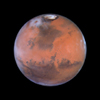The Future
Next Stop: Mars
 The next great dream for space exploration is to send humans to Mars. The red planet is considered to be the "friendliest" of the other planets for human exploration.
The next great dream for space exploration is to send humans to Mars. The red planet is considered to be the "friendliest" of the other planets for human exploration.
Mercury is too hot and has almost no atmosphere. Venus is also too hot, and the pressure at the planet's surface is too severe. The gas giants--Jupiter, Saturn, Uranus, and Neptune--have no surface on which to land. And Pluto is far too cold and distant.
A Human Mission?
 NASA is exploring the possibility of a human mission to Mars sometime in the future. Here's a quick look at what would probably happen on such a mission:
NASA is exploring the possibility of a human mission to Mars sometime in the future. Here's a quick look at what would probably happen on such a mission:
- rockets would launch parts of a Mars spacecraft into Earth orbit for assembly
- the finished spacecraft travels to Mars and enters orbit around the planet; it would later be used to return astronauts to Earth
- a launch-and-cargo vehicle descends to the planet's surface
- about two years later, an astronaut crew would leave Earth orbit and begin its journey to Mars; the trip would take four to six months
- the crew's spacecraft lands on Mars near the launch-and-cargo vehicle

- the crew spends about a year and a half on Mars; they set up a base and carry out many scientific tests; major goals would include searching for evidence of life and finding ways to create fuel, food, and oxygen on Mars
- the crew packs up collected samples and leaves the planet in the waiting launch-and-cargo vehicle; they ascend to the orbiting spacecraft and return to Earth after about three years away from home
There are many good reasons for sending humans to Mars. Those reasons include:
- building our knowledge and experience
- developing new technologies, and
- searching for evidence of life beyond Earth
 But such a mission is likely quite a few years away. Here are a few of the reasons why:
But such a mission is likely quite a few years away. Here are a few of the reasons why:
- sending people on long space missions costs an enormous amount of money and other resources; governments want to do many things, but their budgets are limited
- in the past, major human space missions have been driven by political goals; for example, the Cold War sparked the space race and the Apollo missions; currently, there is no such political "spark" to justify a human mission to Mars
- Mars astronauts would be far from help from Earth; for this reason, they would have to gain a wide range of new skills, training, and support to take care of themselves
- the health and safety of the crew would be key concerns; for example, we need to know more about how to protect astronauts from the harmful effects of long-term exposure to microgravity
- we also need to prepare for the human factors of long space missions; for example, how people from very different backgrounds and cultures get along while under pressure for long periods
- we need further advancements in medicine, technology, and other sciences
For now, the space shuttle and the International Space Station remain the focus of NASA's human space missions. Both of these programs are developing our ability to explore beyond Earth orbit.
Unpiloted Missions
In the meantime, unpiloted missions will continue to explore the solar system. These missions help to pave the way for later human exploration. Here are a few highlights of upcoming robotic missions:
- Mars Express -- scheduled for launch in 2003, this combined European Space Agency/NASA mission will explore the atmosphere and surface of Mars from orbit around the planet's poles; involves both an orbiter and a lander
Learn more about the Mars Express.

-
Mars Exploration Rovers -- also set for launch in 2003, the mission involves two rovers that will detect and analyze minerals and water samples
Learn more about the Mars Exploration Rovers.

- Mars Reconnaissance Orbiter -- this orbiter, scheduled for launch in 2005, will analyze the surface at high resolution in an effort to detect water
Learn more about the Mars Reconnaissance Orbiter.
- Mars Sample Return Lander -- an ambitious plan to return the first samples of the Martian surface to Earth; this mission could launch as early as 2014
Learn more about the Mars Sample Return Lander.
 Other robotic missions (such as CONTOUR and Deep Impact) will study comets. Still others (MESSENGER) will study the planet Mercury.
Other robotic missions (such as CONTOUR and Deep Impact) will study comets. Still others (MESSENGER) will study the planet Mercury.
Learn more about CONTOUR, Deep Impact, and MESSENGER.
Explore the table of Unpiloted Space Exploration for a more in-depth look at the history and future of unpiloted space missions.
Take a look at what NASA has in mind for the future of the space program.
*Note: The feature you are reading was produced in May 2002. At that time, the future of some space missions--including the International Space Station and the Mars Sample Return Lander--was uncertain. Some missions have been cut back, delayed, or cancelled due to funding problems. For the latest information on these missions, please visit the following web sites: